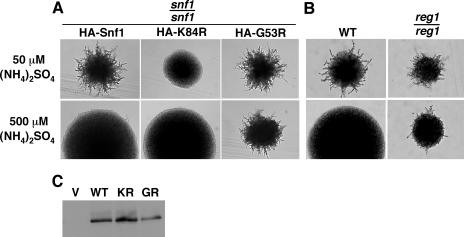FIG. 3.
Effects of inactive and hyperactive Snf1 on PH differentiation. (A) A snf1/snf1 diploid, MCY4473, was transformed with plasmids pSK119, pSK120, or pIT517 expressing HA-Snf1, catalytically inactive HA-Snf1-K84R (HA-K84R), and hyperactive HA-Snf1-G53R (HA-G53R), respectively. Immunoblot analyses indicated that all HA-tagged proteins are expressed (panel C). Strains were examined for PH differentiation on SLAD and SMAD media containing 50 μM and 500 mM ammonium sulfate as the sole nitrogen source, respectively; colonies were photographed after 3 days at 30°C. Cells expressing no Snf1 protein (carrying the corresponding empty vector pWS93) failed to undergo PH differentiation under either condition (not shown). (B) Wild-type diploid MCY4472 (WT) and KY43 (reg1/reg1) were examined for PH differentiation as described above. Both strains carried pLCLG-Staf (31), a centromeric plasmid with LEU2 and URA3 to confer prototrophy. (C) Cells analyzed in panel A were grown to mid-log phase in nutrient-rich synthetic medium with plasmid selection and shifted to liquid SLAD medium for 2 h, and levels of the HA-Snf1 proteins were compared by immunoblotting with anti-HA. V, vector pWS93; WT, HA-Snf1; KR, HA-Snf1-K84R; GR, HA-Snf1-G53R.

